Chapter 5: Towing Capacity
CHAPTER 5: TOWING CAPACITY
BLUE OX TOWING GUIDE
Towing Capacity Guide
Towing capacity is the maximum weight your vehicle can pull safely and legally. Every tow setup depends on matching the right trailer to the right tow vehicle, and that starts with understanding how towing capacity works. Weight ratings, axle loads, and load distribution all factor into what your rig can safely handle. Misjudging that number can lead to blown transmissions, warped brakes, or accidents.
Towing Capacity Definitions
Understanding a few key terms can make towing easier and safer. This section breaks down the basics, so you know what numbers matter and why they’re important.
| Term (Acronym) | Definition | Why It Matters | Where to Find It |
|---|---|---|---|
| Gross Vehicle Weight Rating (GVWR) | Maximum loaded weight of a single vehicle (including passengers, cargo, and fluids). The tow vehicle and trailer each have their own GVWR. | Exceeding the GVWR puts excessive stress on your vehicle's suspension, brakes, tires, and frame, potentially leading to component failure and unsafe driving conditions. | Check the door jamb label (often on the driver’s side), the vehicle’s manual, or the data plate on the vehicle body. |
| Gross Combined Weight Rating (GCWR) | Maximum allowable weight of both the tow vehicle and the attached trailer combined, including all cargo, passengers, and fluids in both. | Staying within the GCWR ensures your vehicle's engine, transmission, brakes, and frame can safely handle the total weight of the combined setup, preventing overheating, brake failure, and loss of control. | Look in the manufacturer’s manual or technical specifications, the door jamb sticker, or the dealer’s documentation/website. |
| Gross Axle Weight Rating (GAWR) | Maximum weight each individual axle (front and rear are rated separately) is designed to safely support. | Overloading an axle can damage axle components, tires, and suspension, negatively impacting vehicle handling, braking performance, and overall safety. | This information is typically on the door sticker or label on the vehicle, in the owner’s manual, or on the manufacturer’s specification sheet. |
| Curb Weight | The weight of an empty vehicle with all standard equipment and necessary operating fluids (like fuel and oil), but without any passengers or cargo. | Knowing the curb weight allows you to calculate your vehicle's payload capacity (GVWR - Curb Weight = Payload Capacity). This tells you how much weight you can add in passengers, cargo, and trailer tongue weight without exceeding the vehicle's GVWR. | Check the owner’s manual, the manufacturer’s specification sheet, or sometimes a data label on the vehicle. |
| Payload | The maximum weight of passengers, cargo, added equipment, and trailer tongue weight that a vehicle can safely carry, determined by its GVWR minus its curb weight. | Overloading is unsafe and potentially illegal. It negatively affects handling and braking, stresses components like suspension and tires, and increases accident risk. | Look for the 'Tire and Loading Information' sticker on the driver's side door jamb (often specifies max weight for 'occupants and cargo'). Alternatively, check the owner's manual for GVWR and Curb Weight to calculate it. |
| Dry Weight / Unloaded Vehicle Weight (UVW) | The weight of a vehicle or trailer as it leaves the manufacturer, without fluids (like water or propane), cargo, passengers, or optional equipment. Often used for trailers (as UVW). | Dry weight serves as the baseline starting point for calculating how much cargo and fluid weight you can add to a trailer before reaching its GVWR. It's often significantly less than the actual weight when ready to tow (GTW). | Look at the technical specifications from the manufacturer, product brochures, technical sheets, or detailed specs in the owner’s manual. Often found on a sticker on the RV itself. |
| Gross Trailer Weight (GTW) | The actual measured weight of a fully loaded trailer, including the trailer itself plus all cargo, water, propane, etc. | Knowing the GTW is crucial to ensure you do not exceed the trailer's own GVWR, the tow vehicle's towing capacity, or the GCWR. Overloading the trailer can lead to tire blowouts, axle failure, and instability. | The most accurate GTW is measured using a truck scale (like a CAT scale). You can also find the trailer's empty weight and maximum capacity (GVWR) in the trailer manufacturer’s documentation or placard, or dealer specifications, to calculate potential loaded weight. |
| Tongue Weight (TW) | The downward force that the fully loaded trailer's tongue exerts on the tow vehicle's hitch. | Proper tongue weight (typically 10-15% of GTW for conventional trailers) is critical for stable, safe towing. Too little tongue weight can cause dangerous trailer sway, while too much can overload the tow vehicle's rear axle, affecting steering and braking. | It can be measured directly using a specialized tongue weight scale. Estimates can be found in the trailer manufacturer’s specs, but measuring the actual loaded trailer is recommended. You can also consult a towing specialist. |
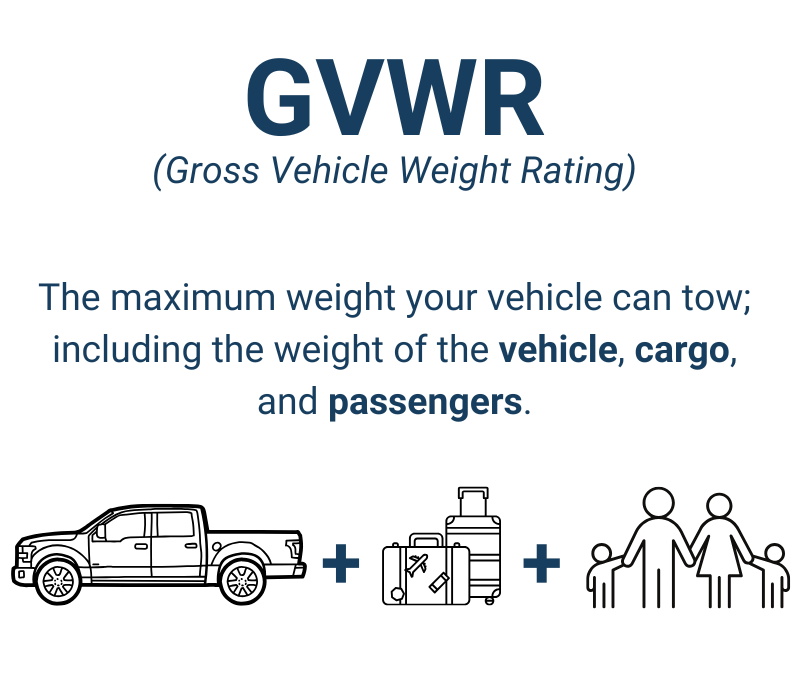
Gross Vehicle Weight Rating (GVWR)
Definition: Maximum loaded weight of a single vehicle (including passengers, cargo, and fluids). The vehicle and trailer each have their own GVWR.
Why it matters: Exceeding the GVWR puts excessive stress on your vehicle's suspension, brakes, tires, and frame, potentially leading to component failure and unsafe driving conditions.
Where to find: Check the door jamb label (often on the driver’s side), the vehicle’s manual, or the data plate on the vehicle body.
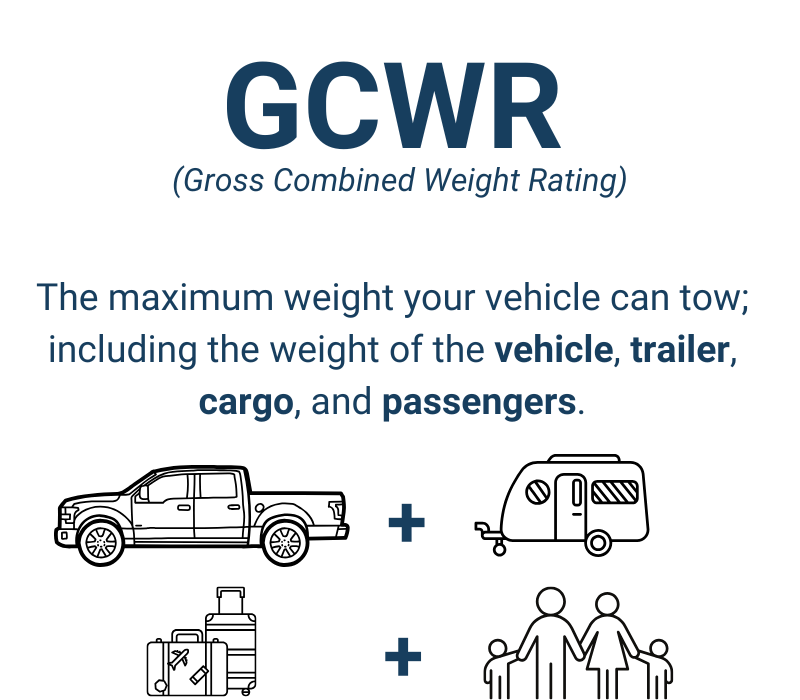
Gross Combined Weight Rating (GCWR)
Definition: Maximum allowable weight of both the tow vehicle and the attached trailer combined, including all cargo, passengers, and fluids in both.
Why it matters: Staying within the GCWR ensures your vehicle's engine, transmission, brakes, and frame can safely handle the total weight of the combined setup, preventing overheating, brake failure, and loss of control.
Where to find: Look in the manufacturer’s manual or technical specifications, the door jamb sticker, or the dealer’s documentation/website.
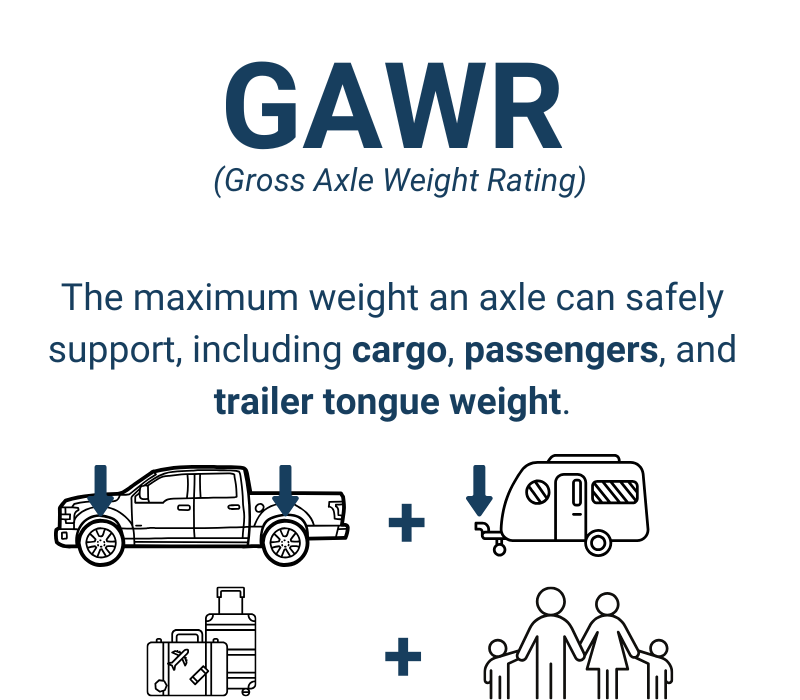
Gross Axle Weight Rating (GAWR)
Definition: Maximum weight each individual axle (front and rear are rated separately) is designed to safely support.
Why it matters: Overloading an axle can damage axle components, tires, and suspension, negatively impacting vehicle handling, braking performance, and overall safety.
Where to find: This information is typically on the door sticker or label on the vehicle, in the owner’s manual, or on the manufacturer’s specification sheet.
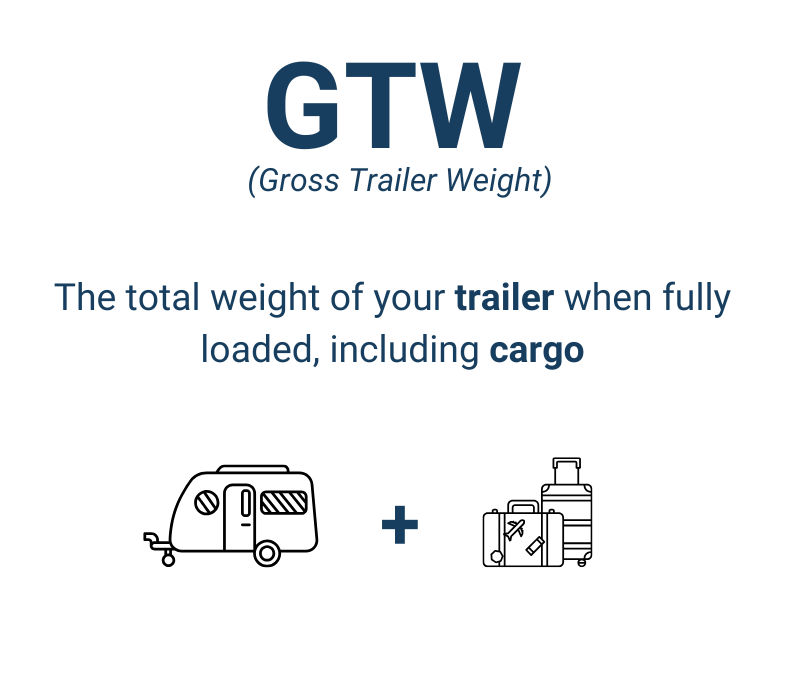
Gross Trailer Weight (GTW)
Definition: The actual measured weight of a fully loaded trailer, including the trailer itself plus all cargo, water, propane, etc.
Why it matters: Knowing the GTW is crucial to ensure you do not exceed the trailer's own GVWR, the tow vehicle's towing capacity, or the GCWR. Overloading the trailer can lead to tire blowouts, axle failure, and instability.
Where to find: The most accurate GTW is measured using a truck scale (like a CAT scale). You can also find the trailer's empty weight and maximum capacity (GVWR) in the trailer manufacturer’s documentation or placard, or dealer specifications, to calculate potential loaded weight.
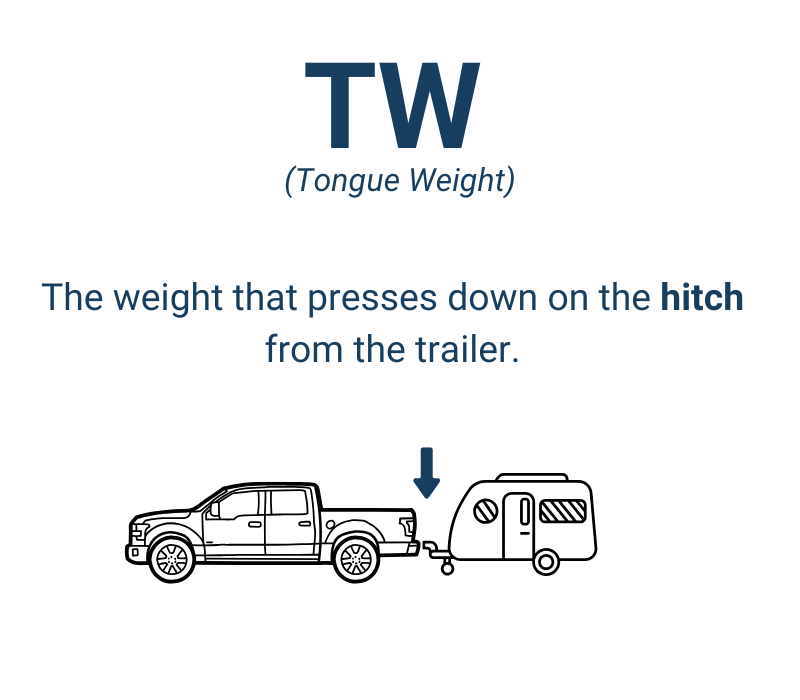
Tongue Weight (TW)
Definition: The downward force that the fully loaded trailer's tongue exerts on the tow vehicle's hitch.
Why it matters: Proper tongue weight (typically 10-15% of GTW for conventional trailers) is critical for stable, safe towing. Too little tongue weight can cause dangerous trailer sway, while too much can overload the tow vehicle's rear axle, affecting steering and braking.
Where to find: It can be measured directly using a specialized tongue weight scale. Estimates can be found in the trailer manufacturer’s specs, but measuring the actual loaded trailer is recommended. You can also consult a towing specialist.
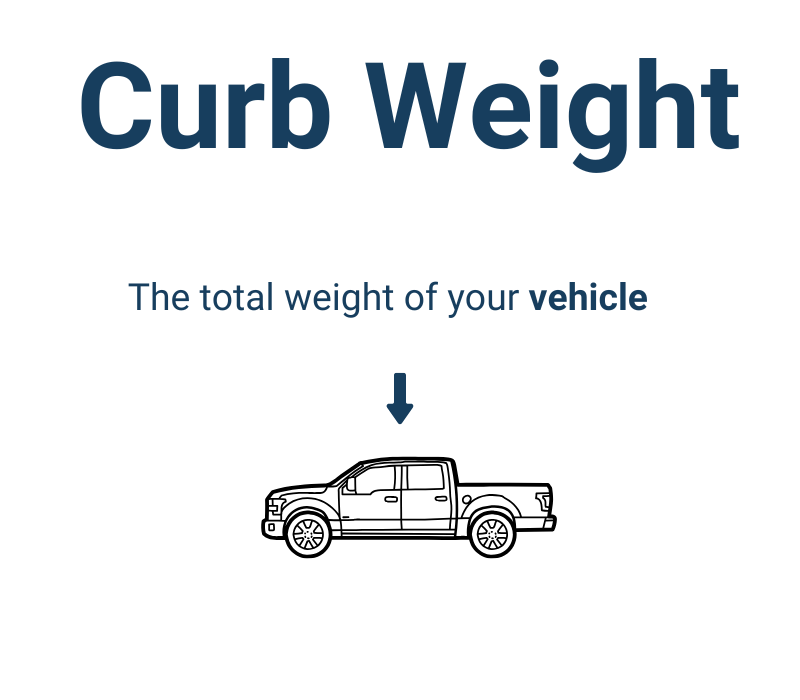
Curb Weight
Definition: The weight of an empty vehicle with all standard equipment and necessary operating fluids (like fuel and oil), but without any passengers or cargo.
Why it matters: Knowing the curb weight allows you to calculate your vehicle's payload capacity (GVWR - Curb Weight = Payload Capacity). This tells you how much weight you can add in passengers, cargo, and trailer tongue weight without exceeding the vehicle's GVWR.
Where to find: Check the owner’s manual, the manufacturer’s specification sheet, or sometimes a data label on the vehicle.

Dry Weight
Definition: The weight of a vehicle or trailer as it leaves the manufacturer, without gas, cargo, passengers, or optional equipment. Also known as Unloaded Vehicle Weight (UVW) for trailers.
Why it matters: Dry weight serves as the baseline starting point for calculating how much cargo and fluid weight you can add to a trailer before reaching its GVWR. It's often significantly less than the actual weight when ready to tow (GTW).
Where to find: Look at the technical specifications from the manufacturer, product brochures, technical sheets, or detailed specs in the owner’s manual. Often found on a sticker on the RV itself.
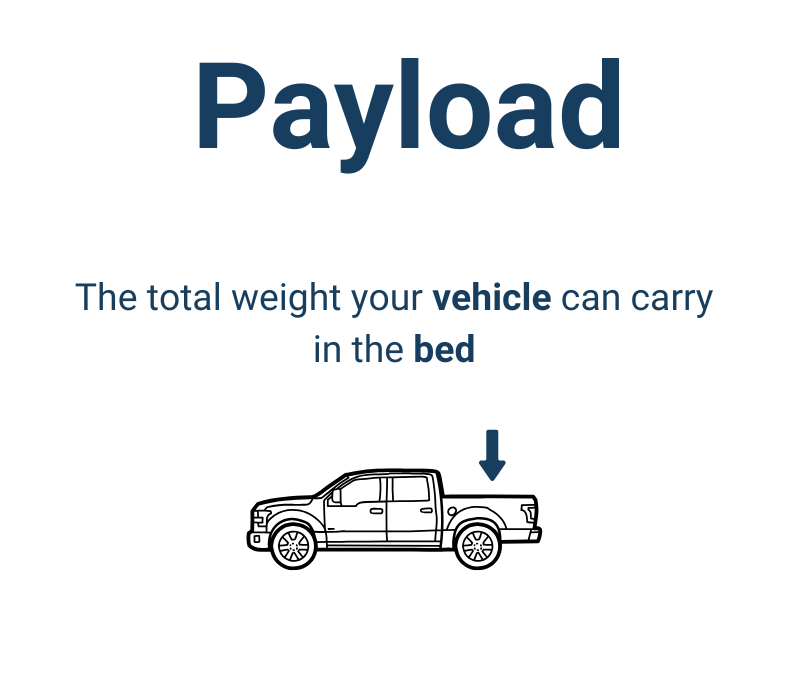
Payload
Definition: The maximum weight of passengers, cargo, added equipment, and trailer tongue weight that a vehicle can safely carry, determined by its GVWR minus its curb weight.
Why it matters: Overloading is unsafe and potentially illegal. It negatively affects handling and braking, stresses components like suspension and tires, and increases accident risk.
Where to find: Look for the 'Tire and Loading Information' sticker on the driver's side door jamb (often specifies max weight for 'occupants and cargo'). Alternatively, check the owner's manual for GVWR and Curb Weight to calculate it.
How to Find Your Vehicle’s Towing Capacity
Finding the correct towing capacity and associated weight limits for your specific vehicle is crucial. Don't guess or assume based on similar models. Here’s where to look:

- Owner’s Manual: Look for the towing section. It lists capacities based on engine, drivetrain, axle ratio, and tow package.
- Door Jamb Sticker: Check the driver’s door frame for GVWR, GAWR, and payload info. These help calculate safe towing limits.
- Manufacturer Website / VIN Lookup: Use your VIN or vehicle model/year to find exact towing specs and equipment details online.
- Dealer Documents: The window sticker or sales paperwork might show towing info. Just make sure to verify it.
Calculating Towing Capacity
Your vehicle's listed tow rating is just a starting point. Always use your trailer's actual loaded weight (GTW), not the 'dry weight' from brochures.
One key check involves the Gross Combined Weight Rating (GCWR).
Use this formula: Towing Capacity = GCWR - (Curb Weight + Payload)
The result shows the max trailer weight allowed to stay within the combined limit.
But, this calculated number is not your final capacity. Remember, your towing setup is only as strong as its weakest part. Compare it to these ratings:
- Vehicle's Maximum Tow Rating
- Hitch receiver rating
- Ball mount rating
- Hitch ball rating
Your actual safe towing capacity is the lowest of all these limits.
Towing Capacity Calculator
This calculation provides an estimate only. Always consult your vehicle's owner's manual and confirm specific weight ratings (GVWR, GAWR, Tongue Weight, etc.) before towing. Factors like altitude and road conditions can also affect towing capacity.
Towing Capacity in Action: Examples
A few examples for calculating towing capacity.
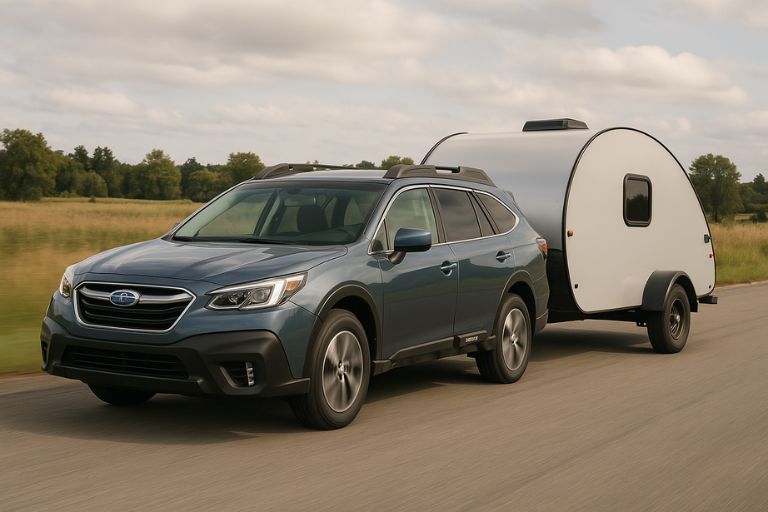
Subaru + Teardrop
Lightweight setup. Check if your Subaru’s rated towing capacity can handle a small teardrop trailer.
GCWR: 7,000 lbs
Curb Weight: 3,500 lbs
Payload: 1,000 lbs
Towing Capacity = 7,000 - (3,500 + 1,000) = 2,500 lbs
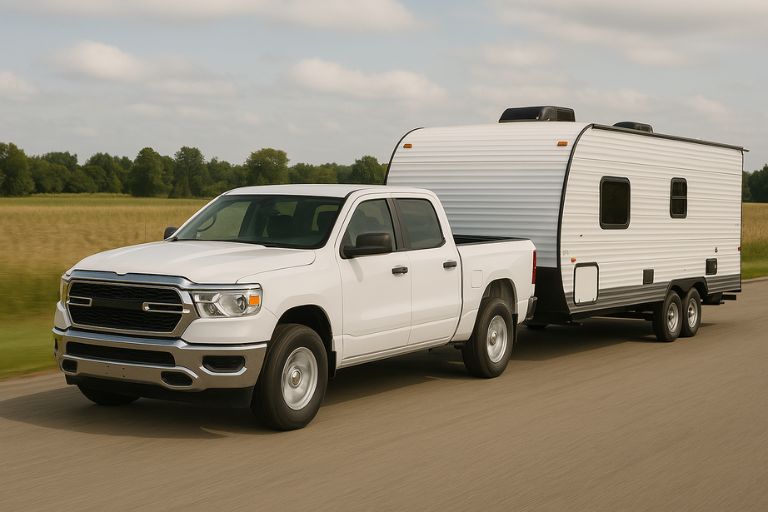
Half Ton + Travel Trailer
Common setup. Consider GCWR, payload, and hitch rating for a half-ton pickup and travel trailer combination.
GCWR: 15,000 lbs
Curb Weight: 5,500 lbs
Payload: 2,000 lbs
Towing Capacity = 15,000 - (5,500 + 2,000) = 7,500 lbs
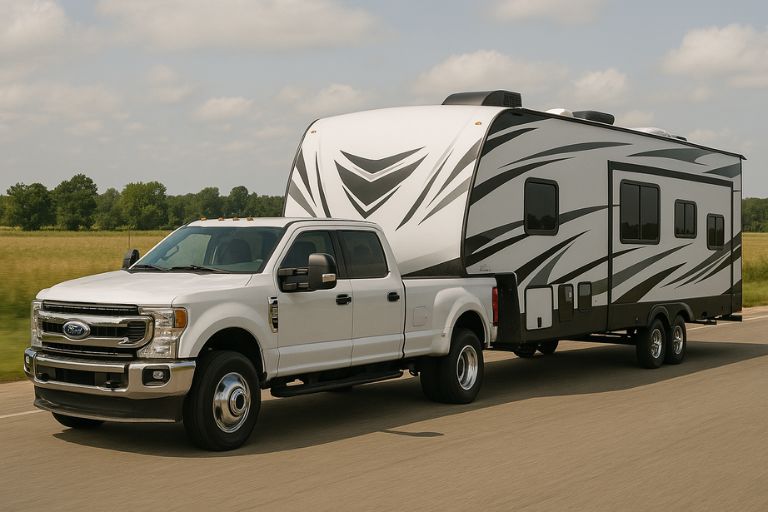
F350 + Toy Hauler
Heavy-duty combo. Consider trailer brakes and other towing factors with an F-350 and toy hauler.
GCWR: 31,000 lbs
Curb Weight: 8,000 lbs
Payload: 5,500 lbs
Towing Capacity = 31,000 - (8,000 + 5,500) = 17,500 lbs
Hitch Class Towing Capacity
Always match the hitch class to both your vehicle’s and trailer’s specifications.
| Hitch Class | Towing Capacity | Typical Use |
|---|---|---|
| Class I | Up to 2,000 lbs | Light towing; small trailers or bikes |
| Class II | Up to 3,500 lbs | Small trailers, utility trailers |
| Class III | Up to 5,000 lbs | Medium-duty towing; common in SUVs/trucks |
| Class IV | Up to 10,000 lbs | Heavier trailers; larger towing setups |
| Class V | Up to 20,000 lbs | High-performance or commercial towing |
Typical Towing Capacity Ranges
These capacity ranges are estimates. Actual capacities vary by engine, transmission, and packages.
| Vehicle Type | Towing Capacity Range | Examples |
|---|---|---|
| Subcompact Crossover | 1,500–3,500 lbs | Subaru Crosstrek, Jeep Compass |
| Small SUV | 1,500–3,500 lbs | Toyota RAV4, Ford Escape |
| Midsize SUV | 3,500–6,000 lbs | Kia Telluride, Nissan Pathfinder |
| Large SUV | 7,500–9,300 lbs | GMC Yukon, Ford Expedition |
| Midsize Pickup | 6,000–7,700 lbs | Nissan Frontier, Chevy Colorado |
| Full-Size Pickup | 9,000–13,300 lbs (or more) | Toyota Tundra, Chevy Silverado |
| Heavy-Duty Pickup | 15,000–37,000+ lbs (gooseneck) | Ford F-350 Super Duty, Ram 3500 HD |
| Full-Size Van | 5,000–7,500 lbs | Ford Transit, Mercedes Sprinter |
Factors That Affect Towing Capacity
Towing capacity isn’t just about the engine. Several mechanical factors affect how much weight your vehicle can handle. Two trucks with the same engine can have very different towing ratings depending on axle ratio, suspension setup, and transmission strength. Factory tow packages often include upgrades that raise the capacity rating, while base models might fall short. Knowing how your vehicle is equipped helps you avoid overloading or misjudging what it can safely tow.
| Factor | Description |
|---|---|
| Engine and Transmission | Torque matters more than horsepower. A diesel with a strong transmission usually pulls more than a gas engine with a weak one. |
| Axle Ratio | A lower ratio (numerically higher) boosts pulling power. For example, a 3.73 or 4.10 axle can tow more than a 3.23. |
| Drivetrain | 4WD systems often lower towing capacity slightly due to added weight. |
| Wheelbase | Longer wheelbases offer better trailer control and stability. |
| Suspension | Soft suspensions reduce payload and make towing less stable. |
| Cooling Systems | Towing puts heat on the engine and transmission. Factory tow packages usually add upgraded radiators and coolers. |
| Air Ride Control | Air suspension systems can help level the vehicle under load, but depending on how they’re configured, they can also limit overall towing capacity. |
| Sway | Side-to-side trailer sway can reduce control and safety. Factors like wind, speed, trailer length, and hitch type all play a role. |
| Wheels & Tires | Oversized wheels or aggressive off-road tires can throw off gear ratios, reduce torque, and impact stability; all of which hurt towing performance. |
| Aerodynamics & Aftermarket Mods | Roof racks, lift kits, or body modifications can reduce fuel efficiency and towing stability, especially at highway speeds. |
Blue Ox Tip
Weight distribution and hitch choice matter too. A SwayPro or TrackPro weight-distribution hitch shifts tongue weight evenly to your front axle and trailer axles, reducing sag and improving control.
Towing Capacity by Towing Style
Each style of towing has different weight considerations. Here's how towing capacity applies across four common setups.
Standard Trailer Towing
With bumper-pull trailers, tongue weight sits directly on the hitch and counts against your vehicle’s payload. A properly sized weight-distribution hitch like the Blue Ox TrackPro can return steering control to the front axle while keeping the trailer steady under load. Always factor tongue weight into your payload math, not just trailer weight.
Travel Trailer Towing
Travel trailers add more drag and sway potential than other setups. Loaded weight adds up fast; water tanks (8.3 lbs per gallon), gear, camping supplies, and propane all stack weight on the axles and hitch. Use a SwayPro or 2-Point hitch to stabilize the trailer, and don’t forget to re-measure tongue weight after loading up.
5th Wheel Towing
Fifth wheel trailers shift the pin weight over the rear axle, not the bumper. That gives them better stability and reduces sway. However, that pin weight still eats into your payload. If your truck has a 2,000 lb payload and your pin weight is 2,200 lbs, you’re already overloaded before adding passengers or fuel. Use a properly rated Blue Ox 5th Wheel Hitch designed to match your trailer’s weight class and mounting system.
Flat Towing
Flat towing means your motorhome pulls a vehicle with all four wheels on the ground. Towing capacity here refers to the hitch rating and GCWR of the motorhome. You’ll need to calculate the combined weight of the motorhome, passengers, fluids, fuel, and the flat towed vehicle with accessories.
Towing Capacity Safety Tips
Remember, your towing setup is only as strong as its weakest part. Never max out your ratings. Stay at least 10–15% below your max towing capacity. That margin gives your brakes, transmission, suspension, and cooling system room to breathe, especially in hills, heat, or wind.
Legal towing limits vary by state or province. Some require auxiliary braking systems for trailers over a certain weight, others limit total length. It’s your responsibility to know what applies where you’re driving. Ensure all components in your towing setup, including the truck, hitch receiver, ball mount, hitch ball, safety chains, trailer coupler, and the trailer itself have weight ratings that meet or exceed the trailer's weight, since the component with the lowest rating determines your actual maximum towing capacity, regardless of the truck's individual rating.
Your towing setup is only as strong as its weakest part.
Check the weight ratings on everything – your truck, hitch receiver, ball mount, hitch ball, safety chains, and the trailer itself. The lowest rating dictates your actual maximum towing weight, no matter what the truck is rated for.
Load the trailer properly.Aim for about 60% of the cargo weight in front of the trailer axle(s) and 40% behind it. Balance the weight side-to-side too. Correct loading is key to preventing dangerous trailer sway.
Secure everything in or on the trailer.Use straps, chains, or nets so your load can't shift. A shifting load can throw off the balance and make handling unpredictable.
Check trailer lights and brakes before every trip.Make sure turn signals, brake lights, and running lights work correctly with your tow vehicle. If your trailer has brakes, test the controller.
Use towing mirrors.Standard mirrors often leave big blind spots when towing. Proper towing mirrors let you see what's happening alongside your trailer.
Remember stopping takes much longer when towing.The heavier the load, the more distance you'll need. Increase your following distance significantly.
Drive slower than you normally would.Speed makes potential problems like sway much worse and cuts down your reaction time. Take it extra easy on hills (use lower gears going down), around turns, and in bad weather.
Practice makes perfect.Towing changes how your vehicle handles, especially backing up. Find a big empty lot to practice turning and reversing. Use a spotter when backing up if possible.
Plan your route ahead of time.Try to avoid very steep hills, sharp curves, heavy traffic areas, or routes with low bridges or tunnels that your trailer might not fit under.
Know the local towing laws.Rules about required trailer brakes, maximum weights, and total length can vary by state or province. It's your responsibility to know and follow them.
Keep up with maintenance.Towing puts extra stress on your vehicle and trailer. Regularly check: Brakes (vehicle and trailer), Tires (pressure and condition on both), Suspension (both), Vehicle Fluids (engine oil, transmission fluid, coolant), and all Hitch Components (receiver, ball mount, ball, coupler, chains) for wear or damage.
Taking these steps seriously every time you tow helps keep you and everyone else on the road safe.
Stay Safe, Tow Smart
Towing capacity isn’t just a technical number—it’s a safety guideline that keeps your vehicle, trailer, and family protected on the road. Always match your rig to your real-world needs, not just sticker specs. Blue Ox builds towing accessories that make it easier to stay within safe towing limits, while giving you the control, comfort, and confidence to go the distance. Have more questions about towing? Reach out to our towing experts by calling 800-228-9289.
Towing Capacity Frequently Asked Questions (FAQs)
“Is the GVWR the actual weight of my vehicle?”
No. GVWR (Gross Vehicle Weight Rating) is the maximum allowed weight limit for the vehicle when fully loaded. The actual, current weight (which you find on a scale) must always be less than or equal to the GVWR
“What happens if I exceed GVWR or GCWR?”
Exceeding these ratings puts immense stress on your vehicle's frame, suspension, axles, brakes, engine, and transmission. It can lead to component failure, loss of control, inability to stop effectively, voided warranties, and potential legal liability in an accident. It's dangerous and potentially very costly.
“Does curb weight include the driver?”
Generally, no. Curb weight typically includes standard equipment and a full tank of fuel/fluids but excludes the driver, passengers, cargo, and any optional equipment or aftermarket additions.
“Where can I find my vehicle’s actual weight?”
The most accurate way is to weigh it on a certified scale, like a CAT scale found at truck stops. The door sticker lists rated limits (GVWR/GAWR/Payload), and the manual lists curb weight, but only a scale tells you the actual current weight.
“How close to max towing capacity is safe? What’s the 80% or 85% Towing Rule?”
While not a hard rule, experts strongly recommend staying well below your maximum limits. The "80% Rule" (or 85%) is a guideline suggesting you should aim for your fully loaded trailer weight (GTW) to be no more than 80-85% of your vehicle's maximum tow rating. This provides a crucial safety margin for handling, braking, and component longevity, especially in adverse conditions. Always adhere to all weight limits (GVWR, GCWR, GAWR, Payload, Hitch).
“Is my towing capacity affected by the trim level or options on my vehicle?”
Yes. Engine size, transmission type, axle ratio, drivetrain (2WD/4WD), wheelbase, and the presence (or absence) of a factory tow package can significantly change a vehicle’s towing and payload ratings, even within the same model year. Always verify the ratings for your specific vehicle using the owner's manual, door stickers, or VIN lookup.
“Does the vehicle's towing capacity rating include the weight of the trailer itself?”
Yes. The maximum towing capacity refers to the maximum allowable Gross Trailer Weight (GTW) – which is the weight of the fully loaded trailer, including the trailer's own structure, fluids, and all cargo within or on it.
